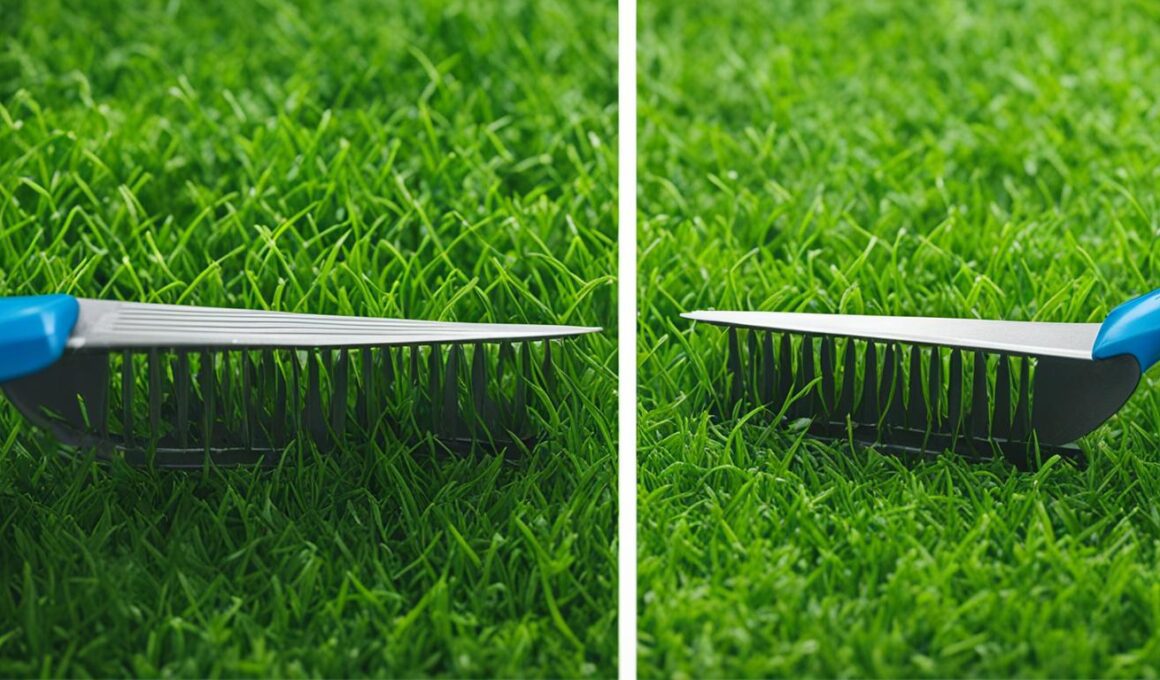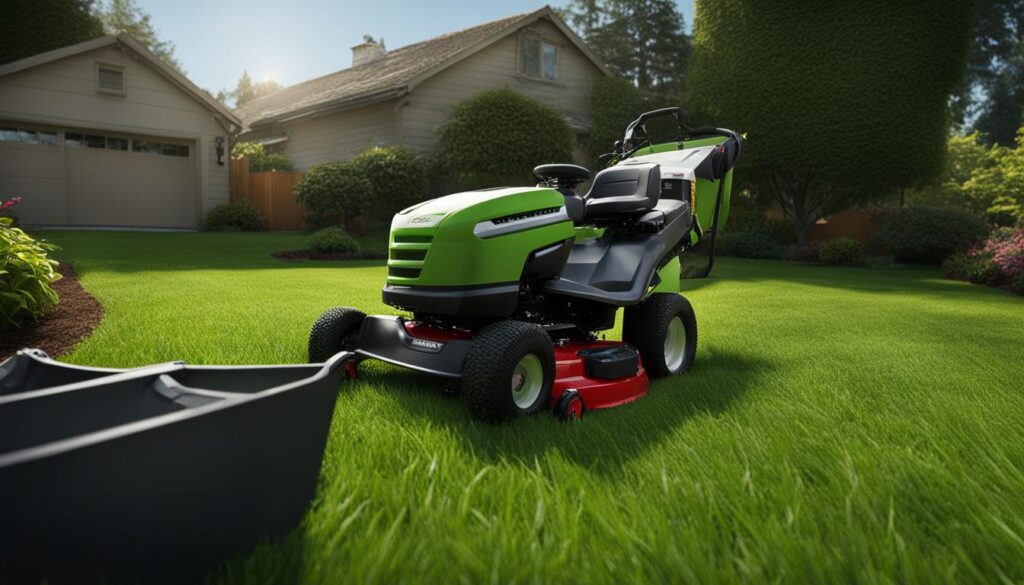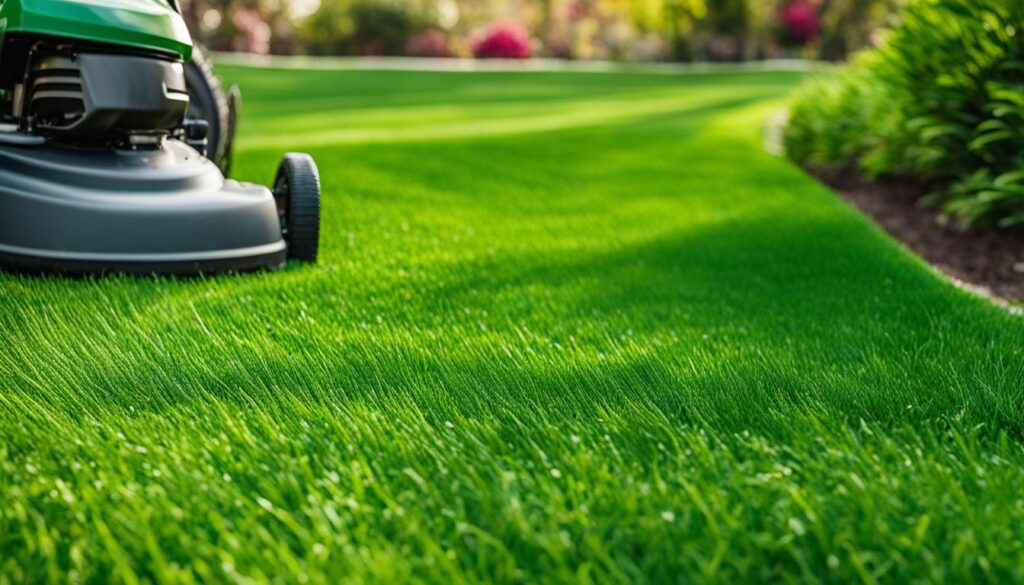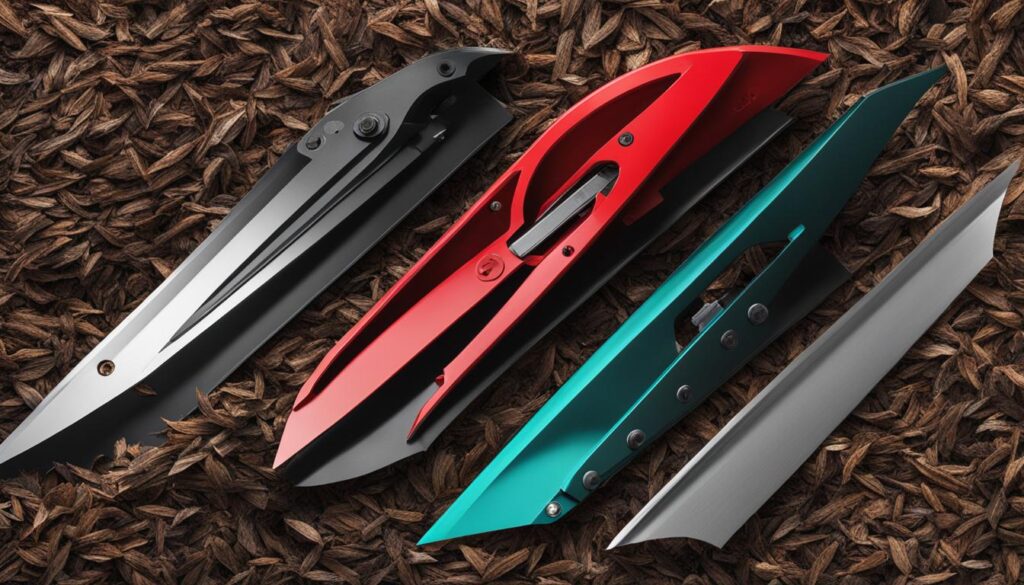When it comes to achieving that perfect lawn, one aspect of landscaping that is often overlooked is the type of mower blade used. Competing for the top spot in your lawn care routine are mulching blades and high lift mower blades, with each playing unique roles in maintaining your lawn’s health and appearance. While the mechanics of each blade design can significantly impact mowing optimization, the ultimate choice comes down to your individual needs and desired outcomes. In this article, we’ll compare mulching and high lift blades and help you decide which one will best suit your needs.
Key Takeaways
- Mulching blades and high lift mower blades serve different purposes in lawn care and maintenance.
- High lift blades focus on cutting and discharging clippings, making them ideal for bagging or collection systems.
- Mulching blades are designed to cut clippings into smaller pieces for efficient recycling, promoting lawn health through natural fertilization.
- Choosing the appropriate blade type depends on your mowing habits, desired lawn appearance, and environmental considerations.
- Proper mower blade selection can significantly impact the overall health, look, and sustainability of your lawn.
Understanding Mower Blade Basics
Standard mower blades and mulching mower blades differ in design, purpose, and cutting performance. While standard blades focus on efficient grass cutting and discharging, mulching blades excel in finely chopping grass clippings and redistributing them onto the lawn. Knowing the differences between these two blade types helps you select the best mower blade for your lawn’s needs.
Defining Standard and Mulching Mower Blades
Standard mower blades, also known as high lift blades, are designed to create airflow that lifts grass for even cutting and discharging clippings. These blades discharge clippings onto the lawn or into a collection system, like a bag or a container. This makes them suitable for side-discharge mowers and bagging systems.
Mulching mower blades, also called “3-in-1” or “all-purpose” blades, are engineered with a curved design and additional cutting surfaces, referred to as the “+ design.” This design helps chop grass clippings finely and redistribute them onto the lawn, providing natural fertilization.
How Blade Design Influences Cutting and Discharging
Standard blade aerodynamics: The aerodynamic design of high lift blades creates a powerful lift that efficiently discharges grass clippings during each mowing pass. This ensures a clean and professionally manicured lawn appearance. The design of standard mower blades makes them suitable for bagging, as they send clippings directly into a rear or side collection system.
Mulching blade efficiency: The curved shape of mulching blades promotes the recirculation of clippings beneath the mower deck. This allows for re-cutting and fine chopping of grass clippings, making them small enough to decompose quickly and provide nutrients back to the lawn. Though this design reduces the discharging efficiency, mulching blades are optimal for Grasscycling—a lawn care technique that relies on natural fertilization and little maintenance.
| Blade Type | Cutting Efficiency | Discharge Efficiency | Best Use |
|---|---|---|---|
| Standard Mower Blades | High | High | Bagging and Side-Discharge Mowers |
| Mulching Mower Blades | High | Low | Grasscycling and Natural Fertilization |
Understanding the blade design differences between standard and mulching mower blades helps you make an informed decision when selecting the best blade option for your lawn care needs. The mower blade you choose affects your mower’s cutting performance, grass discharging, and ultimately, the health and appearance of your lawn.
The Distinct Functions of High Lift Blades
High lift blades play an essential role in effective grass cutting and efficient clipping discharge, particularly when bagging or side-discharging. These blades are designed with specific functions in mind, making them not suitable for mulching tasks. In this section, we will dive into the key functions of high lift blades and explore how their aerodynamic design contributes to their optimal performance.
- Grass Cutting: The primary objective of high lift blades is to provide a clean and even cut to your lawn, making it aesthetically pleasing. These blades are engineered to lift grass upright before cutting it, ensuring better cutting efficiency and consistency.
- Airflow Creation: High lift blades are designed with an aerodynamic shape that generates a higher-lifting airflow. This airflow lifts the grass blades up, facilitating an even mowing experience and leaving a well-groomed appearance.
- Clipping Discharge: The efficient discharge of clippings is crucial in maintaining a clean-cut lawn, and high lift blades excel in this aspect. Their design enables the effective expulsion of grass clippings either back onto the lawn or into a collection system, minimizing the need for raking or cleanup after mowing.
The table below provides an overview of the standard blade uses of high lift blades and highlights their function in grass cutting, airflow creation, and clipping discharge.
| Standard Blade Uses | Function |
|---|---|
| Grass Cutting | Provide even and clean cut for an aesthetically pleasing lawn |
| Airflow Creation | Create high-lifting airflow for better cutting efficiency and consistency |
| Clipping Discharge | Efficiently expel grass clippings back onto the lawn or into a collection system |
In conclusion, high lift blades serve specific functions in the realm of grass cutting, airflow creation, and clipping discharge. Their unique design is essential for delivering optimal performance in settings where mulched clippings are not desired or where collection systems are used. As a result, high lift blades are an indispensable tool for maintaining a pristine-looking lawn when mulching is not a priority.
Advantages of Mulching Blades for Lawn Health
Mulching blades offer a wide range of advantages for improving and maintaining lawn health. These benefits include environmental sustainability, optimal mowing conditions, and cutting edge efficiency, leading to a more beautiful, healthier lawn. In this section, we will discuss the numerous advantages of using mulching blades for your lawn care routine.
The Environmental Benefits of Using Mulching Blades
Utilizing mulching blades is an eco-friendly and sustainable approach to lawn care. By re-cycling airflow and finely chopping grass clippings, these blades return essential nutrients back to the soil as a natural fertilizer. This green method reduces the need for synthetic fertilizers, promoting a healthier environment for your lawn and the surrounding ecosystem.
When to Use Mulching Blades for Best Results
For the best use of mulching blades, it’s crucial to mow at the right time and under optimal conditions. Ideally, your lawn should be mowed every three to four days to prevent overgrowth. Using mulching blades on overly tall grass can lead to clogging and uneven dispersal of clippings. By maintaining a regular lawn maintenance schedule, you’ll provide the most effective environment for mulching blades to thrive.
Mulching Blade Design and Effectiveness
The design of mulching blades features curved surfaces and multiple cutting edges, allowing for efficient chopping of grass clippings. This design diminishes discharging efficiency but optimizes mulching capabilities. The re-cycling airflow beneath the mower deck cuts and re-cuts clippings, redistributing them evenly onto the lawn as a natural, nutrient-rich fertilizer.
- Environmental benefits: Reduce the need for artificial fertilizers by returning essential nutrients to the soil.
- Optimal mowing conditions: Regular lawn maintenance ensures the best results when using mulching blades.
- Cutting edge efficiency: The unique design of mulching blades efficiently chops and redistributes grass clippings.
In conclusion, mulching blades provide several notable advantages for lawn health, including environmental benefits, optimal mowing conditions, and cutting edge efficiency. By incorporating the use of mulching blades into your lawn care routine and following best practices, you can create a sustainable and eco-friendly environment for your lawn to grow and thrive.
How to Choose Between Mulching Blades and High Lift Blades
When it comes to choosing mower blades, understanding the differences between mulching vs high lift options is crucial to making an informed lawn care decision. The ideal blade type for your situation will depend on several factors, including lawn appearance preferences, mowing habits, and prevailing lawn conditions. To help streamline your decision-making process, consider the following comparisons when deciding which blade type is most suitable for your needs.
| Blade Type | Best Suited For | Advantages |
|---|---|---|
| High Lift Blades |
|
|
| Mulching Blades |
|
|
High lift blades excel in situations where grass clippings should be effectively discharged, giving the lawn a cleaner appearance. These blades work well when bagging or side-discharging is preferred, as their aerodynamic design promotes efficient grass cutting and clipping expulsion.
On the other hand, mulching blades are the go-to option if you mow your lawn frequently and aim to utilize grass clippings as a natural fertilizer. By finely chopping and redistributing the clippings onto the lawn, mulching blades promote healthier, more sustainable turf, and reduce the need for artificial fertilizers.
In conclusion, consider your lawn care decision-making priorities when choosing between mulching and high lift blades. Take into account your desired lawn appearance, mowing frequency, and dedication to sustainable practices to select the blade type that aligns with your goals for a healthy, beautiful lawn.
What are the benefits of using High Lift Blades for Mowing?
When it comes to mowing, many people debate between mulching blades vs regular blades. High lift blades, also known as mulching blades, offer several benefits for mowing. They create a powerful suction that lifts the grass for a clean cut, and they also work well for bagging.
Conclusion
In summary, the decision between mulching and high lift blades weighs heavily on designing an effective mowing strategy and cultivating a healthy, visually appealing lawn. Recognizing the distinct purposes and advantages of each blade style is essential in fine-tuning mowing techniques and selecting the appropriate instrument for the desired outcome. Whether your preferences lean towards a pristine appearance or prioritizing environmental sustainability, the correct blade choice can have a significant impact on your lawn’s health and overall aesthetic.
Mowing frequency, prevailing lawn conditions, and desired end results must all be considered when determining the best mower blade for your specific situation. High lift blades excel at bagging and providing a cleaner, polished lawn appearance, while mulching blades prove advantageous when used in tandem with frequent mowing, providing clippings that can serve as natural fertilizer.
Ultimately, achieving the perfect balance between mower blade selection, lawn care practices, and personal preferences will culminate in a refined mowing strategy capable of fostering a lush, well-groomed, and eco-friendly lawn. Don’t underestimate the power of proper mower blade selection when it comes to lawn enhancement. Armed with knowledge and foresight, you will be well-equipped to make informed decisions that positively impact your lawn care journey.











